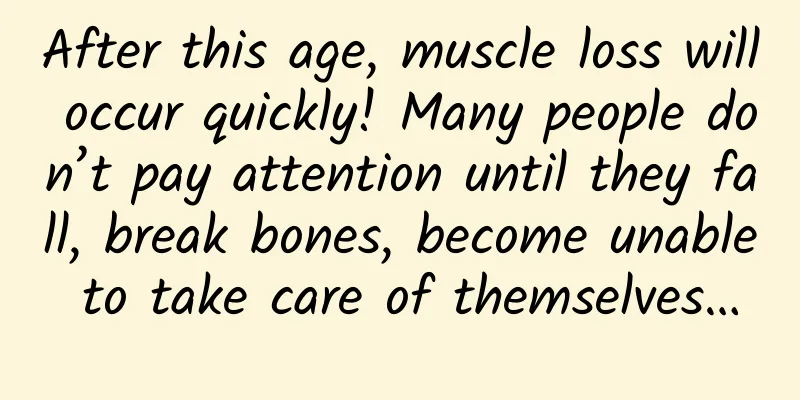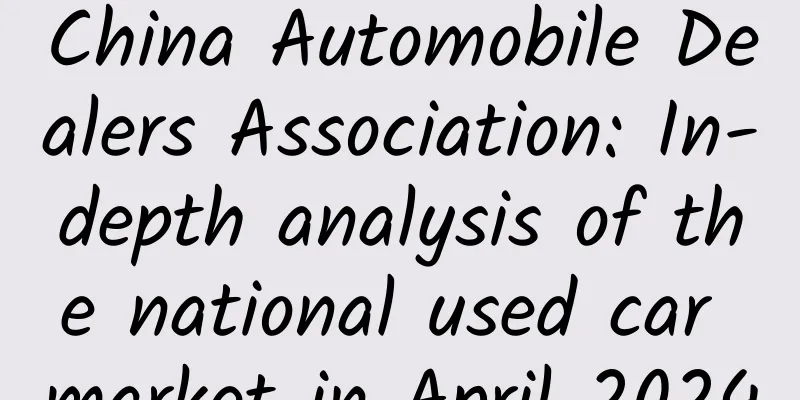After this age, muscle loss will occur quickly! Many people don’t pay attention until they fall, break bones, become unable to take care of themselves…

|
There is a saying that "saving money is not as good as saving muscle". Muscle is one of the most important organs in the human body, which means strength and vitality. What many people don't know is that after a certain age, muscle will be lost in large quantities, which will lead to various adverse events. The human body has more than 600 muscles. Generally speaking, before the age of 40, the mass of muscles will gradually increase, and the strength will gradually increase until it reaches its peak around the age of 40 and remains there. After the age of 50, the amount of skeletal muscle in the human body will gradually decrease, and the strength will gradually decrease. Studies have found that after the age of 50, the mass of leg muscles decreases by 1% to 2% each year, and the strength decreases by 1.5% to 5% each year. According to an epidemiological survey on sarcopenia in the Chinese population, the prevalence of sarcopenia in the elderly in the community is 8.9% to 38.8%, with a higher prevalence in males than in females. The prevalence of sarcopenia increases significantly with age, and the prevalence of sarcopenia in the elderly aged 80 and above can be as high as 67.1%. With the continuous changes in modern people's work and lifestyles, the emergence of a sedentary group in the Internet era, and the current nationwide trend of weight loss, if you do not pay attention to the way you lose weight, it will also increase muscle loss, and the occurrence of sarcopenia will gradually become younger. This is a cross-section of the thigh MRI showing the comparison of muscle mass of a young healthy person and a patient with sarcopenia. Image source: Internet What exactly is sarcopenia? What are the dangers of sarcopenia? How to prevent it? Let’s talk about it in detail today. What is sarcopenia? The concept of sarcopenia was first proposed by Irwin H. Rose of Tufts University in the United States in 1989. It is a disease that affects the elderly and causes progressive loss of skeletal muscle mass, strength and function. Sarcopenia will reduce the quality of life of the elderly, make them more prone to falls and fractures, increase the risk of death, and place a heavy burden on individuals and families. Image source: Internet Sarcopenia is roughly divided into two categories according to the cause: primary sarcopenia and secondary sarcopenia. Primary sarcopenia is mainly caused by age-related aging, with genetic factors being the main cause. Secondary sarcopenia is mainly related to malnutrition, diseases (such as diabetes, disabilities that limit human activities, and chronic heart, lung, liver, kidney diseases, and cerebrovascular diseases), drug abuse, reduced physical activity, and an unhealthy lifestyle (sedentary lifestyle, smoking, and alcoholism). Sarcopenia increases the risk of falls and fractures, reduces the patient's ability to live daily, and is associated with heart disease, respiratory disease, and cognitive impairment; it can lead to motor dysfunction, decreased quality of life, loss of independent living ability, or long-term need for care from others, and an increased risk of death. Sarcopenia increases the risk of hospitalization, increases the cost of care during hospitalization, and increases hospitalization expenses. How can I quickly know if I have sarcopenia? Sarcopenia can be screened using the simple five-item rating questionnaire (SARC-F). Additional assessments include gait speed tests and hand grip strength measurements. 1. Gait speed test: A 6-minute walking test is performed to test the maximum walking speed during the walking process (which can be monitored by wearing a sports watch at home). If the maximum walking speed within 6 minutes is ≤ 0.8 m/s, further measurement and evaluation are performed to confirm the diagnosis. If the maximum walking speed within 6 minutes is > 0.8 m/s, a hand grip strength test should be performed for further screening. 2. Hand grip strength measurement: Under resting conditions, the normal value of the dominant hand grip strength is > 25kg for men and > 18kg for women. If the grip strength is normal, sarcopenia can basically be ruled out; if the grip strength of the dominant hand is lower than normal, further muscle mass examination is required to confirm the diagnosis. If you need to determine the muscle mass, you can go to the hospital for body composition analysis or dual-energy X-ray absorptiometry (DXA) to measure the skeletal muscle mass of the limbs. How to prevent and treat sarcopenia? After confirming sarcopenia, it is necessary to distinguish whether it is primary sarcopenia or secondary sarcopenia. For patients with secondary sarcopenia, the cause of the secondary sarcopenia should be identified and etiological treatment should be carried out. 1 Treatment of the cause For patients with sarcopenia who have underlying diseases, such as diabetes, chronic heart, lung, liver, kidney diseases, and cerebrovascular diseases, it is very helpful to treat the underlying diseases, improve the patients' ability to live, promote physical exercise, and prevent and slow down the loss of muscle mass and strength. Among them, the prevention and treatment of diabetes-related risk factors are particularly important, including insulin resistance, chronic inflammation, mitochondrial dysfunction, neurovascular complications, and poor blood sugar control. Studies have shown that improving insulin resistance, blood pressure, blood lipids and blood sugar control in diabetic patients and controlling diabetic vascular and neuropathy can play a positive role in preventing the occurrence of sarcopenia in diabetic patients and stopping the development of sarcopenia. Risk factors for sarcopenia: unreasonable diet, improper lifestyle, etc. Image source: Reference [1] 2 Correct bad living habits Unhealthy lifestyles such as sitting for long periods of time, smoking, and drinking are significantly associated with the onset of sarcopenia and are also important factors that accelerate the progression of sarcopenia. Therefore, changing unhealthy lifestyles can not only prevent sarcopenia, but is also the most basic treatment for sarcopenia. It is recommended that the elderly and patients with sarcopenia change these unhealthy lifestyles as early as possible. 3 Ensure adequate energy and protein intake For patients with sarcopenia, the recommended daily protein intake is 1.2 to 1.5 g/kg, and sufficient energy and protein intake need to be given based on nutritional assessment; for patients with sarcopenia who are malnourished or at nutritional risk, timely oral enteral nutrition preparations should be supplemented, including protein, amino acids, vitamin D and multivitamins, to reduce the breakdown of muscle protein and promote the synthesis of muscle protein. 4 Exercise intervention Exercise intervention is very important for the prevention and treatment of sarcopenia . On the basis of adequate nutritional supplementation, resistance training, aerobic, stretching and balance exercises should be actively carried out to improve physical function and increase muscle content and strength. For elderly people with chronic diseases, it is recommended that individualized exercise prescriptions be developed by sports medicine or nutrition specialists after the underlying diseases are under control and stabilized. 5 Drug treatment Currently, there is no drug for sarcopenia. Some drugs used to treat other diseases may benefit muscles and thus be used for sarcopenia, including anabolic androgenic hormones, active vitamin D, β-adrenergic receptor stimulants, angiotensin-converting enzyme inhibitors, growth hormone, etc. 6 Preventing adverse events Sarcopenia patients should also pay attention to preventing adverse events. First, a risk assessment of adverse events should be conducted, including a detailed assessment of frailty, susceptibility to falls, and disability risk, so as to provide patients with individualized adverse event intervention plans. Preventing the occurrence of sarcopenia adverse events, especially preventing and reducing fractures, is one of the important goals of sarcopenia treatment. References [1] Liu Juan, Ding Qingqing, Zhou Baiyu, et al. Expert consensus on the diagnosis and treatment of sarcopenia in the elderly in China (2021)[J]. Chinese Journal of Geriatrics, 2021, 40(08):943-952. [2] Dennison EM, Sayer AA, Cooper C. Epidemiology of sarcopenia and insight into possible therapeutic targets. Nat Rev Rheumatol. 2017;13(6):340-347. doi:10.1038/nrrheum.2017.60 [3] Cruz-Jentoft AJ, Bahat G, Bauer J, et al. Sarcopenia: revised European consensus on definition and diagnosis [published correction appears in Age Ageing. 2019 Jul 1;48(4):601]. Age Ageing. 2019;48(1):16-31. doi:10.1093/ageing/afy169 [4] Chinese Medical Association Geriatrics Branch. Chinese expert consensus on the prevention, control and intervention of sarcopenia in the elderly (2023)[J]. Chinese Journal of Geriatrics. Vol. 42, No. 2, February 2023. [5] Bauer J, Morley JE, Schols AMWJ, et al. Sarcopenia: A Time for Action. An SCWD Position Paper. J Cachexia Sarcopenia Muscle. 2019;10(5):956-961. doi:10.1002/jcsm.12483 Planning and production Author: Deng Ting, attending physician of orthopedics department of Changsha Third Hospital Reviewer: Tang Qin, Director and Researcher of the Science Popularization Department of the Chinese Medical Association Planning丨Lin Lin Editor: He Tong Proofread by Xu Lailinlin |
<<: I received a box of hairy crabs, but I can’t finish them. What should I do?
Recommend
[Girls' Emotions] Analyze 90% of emotional problems between the sexes and help you win the battle to defend your love
【Girls' Emotions】Analyzes 90% of emotional pr...
Why do airplane meals taste so bad? It may not be the food that’s to blame
When you are on an airplane, you may have had thi...
As the transformation towards entertainment accelerates, why doesn’t NetQin take off its helmet?
After nearly 10 years of development, NetQin'...
The underlying logic of event planning and promotion!
When it comes to event planning, what everyone th...
Ancient little beast: Although I grow slowly, I live long!
Feng Weimin Recently, an article published in the...
Source code shows Google ruthlessly cuts off Android fingerprint recognition function
Before the launch of Google's new flagship Ne...
"7 tricks + 5 cases" teach you how to make H5 popular in your circle of friends!
People often ask: "What good marketing metho...
Which tablet system is better? iOS 9 vs. Windows 10
As we all know, the tablet market today has been ...
An Shihao appointed head of Volkswagen North American sales
According to foreign media reports, Volkswagen Gr...
How to create a creative H5? Learn about the real H5 in one article
In recent years, H5 has been very popular, and th...
Tik Tok account blocked? Guide to unblocking TikTok account!
If your Douyin account is banned, how should you ...
360 Mini Programs are designed for all scenarios, breaking the boundaries between PC and mobile terminals.
On July 5, 2019, the 360 Mini Program public be...
Analysis of Keep’s model centered on user growth!
The author of this article conducts a detailed an...
How to retain users through membership system? A brief analysis of the Ele.me Super Membership Card!
As a veteran office takeout delivery buyer, I oft...
Can eating snacks help you lose weight? The premise is that you have to do these 4 things!
Snacks include not only fruits, nuts and potato c...









